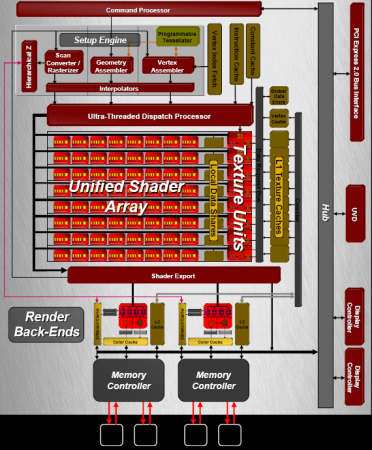Architecture discussion
Architecture discussion
By transitioning to a leaner, meaner 4-series architecture, ATI has pulled the various die-saving benefits across from the Radeon HD 36x0 to HD 4670 and HD 4650. These include stream processors that take up 40 per cent less space, texture units which are 70 per cent smaller, and a better arrangement of cores (SIMDs) - 40 per array - and caches, as you can see in the above diagram. The high-level upshot is that a die-size increase of 24 per cent translates to an SP increase of 267 per cent - or matching that of Radeon HD 3850 and HD 3870.A quadrupling of bilinear-texturing ability doesn't hurt, and the back-end, raster operators, are doubled over the previous generation, too.
Shipping in three flavours from the get-go, HD 4670 will be available with 512MB and 1,024MB frame-buffers, with the choice left to partner. The 512MB model ships at 750MHz core and an effective 2,000MHz memory clock whilst the 1GB board uses the same core/shader speed but reduces effective memory speed to 1,800MHz.
Interestingly, in increasing the memory density, ATI has recommended that partners use regular DDR3 and not the more-expensive GDDR3. The premise here, we suppose, is to keep costs down in what is very much a price-sensitive market.
The cheaper Radeon HD 4650 uses slower DDR2 RAM that's allied to lower core/shader clocks. The differences are in pure clock-speed alone, as the underlying architecture is otherwise identical.
Looking at it across ranges, HD 46x0 has some things in common with Radeon HD 3850. Both harness 320 stream processors, albeit a little differently, and the HD 4670's higher core rate means that it produces, theoretically, almost half a teraFLOPs of compute performance from a £50 etail card.
However, the budget provenance comes through with the die-saving 128-bit memory bus and half-speed texture filtering.










